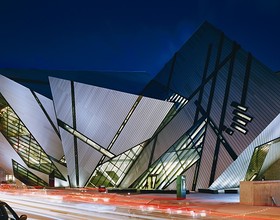ROYAL ONTARIO MUSEUM
-
The extension to the Royal Ontario Museum (ROM), now named the Michael Lee-Chin Crystal, is situated at one of the most prominent intersections in downtown central Toronto. It is the largest Museum in Canada and attracts more than a million visitors a year.
Its new name is derived from the building’s five intersecting metal-clad volumes, which are reminiscent of crystals—inspired by the crystalline forms in the ROM’s mineralogy galleries. Libeskind created a structure of organically interlocking prismatic forms turning this important corner of Toronto, and the entire museum complex, into a luminous beacon.
With the expansion, a new group entrance on Queen’s Park was created where visitors enter a spectacular atrium in which the two themes of the Museum, Nature and Culture, are distinctly showcased through intertwining staircases leading to the exhibitions above.
The entire ground level is unified into a seamless space with clarity of circulation and transparency. The Crystal transforms the ROM’s fortress-like character, turning it into an inspired atmosphere dedicated to the resurgence of the Museum as the dynamic centre of Toronto.
The design succeeds in inviting glimpses up, down, into galleries and even from the street. The large entrance atrium, the Gloria Hyacinth Chen Court, separates the old historic building from the new, providing a nearly complete view of the restored façades of the historic buildings. The Chen Court also serves as a venue space for all kinds of public events.
Opened in June 2007, the extension provides 100,000 square feet of new exhibition space, a new entrance and lobby, a street level retail shop and three new restaurants. Studio Daniel Libeskind also renovated ten galleries in the existing historical building as part of the project.
Photo credits: Elliot Lewis, Royal Ontario Museum, Sam Javanrouh, Michele Nastasi
1870 Projects










